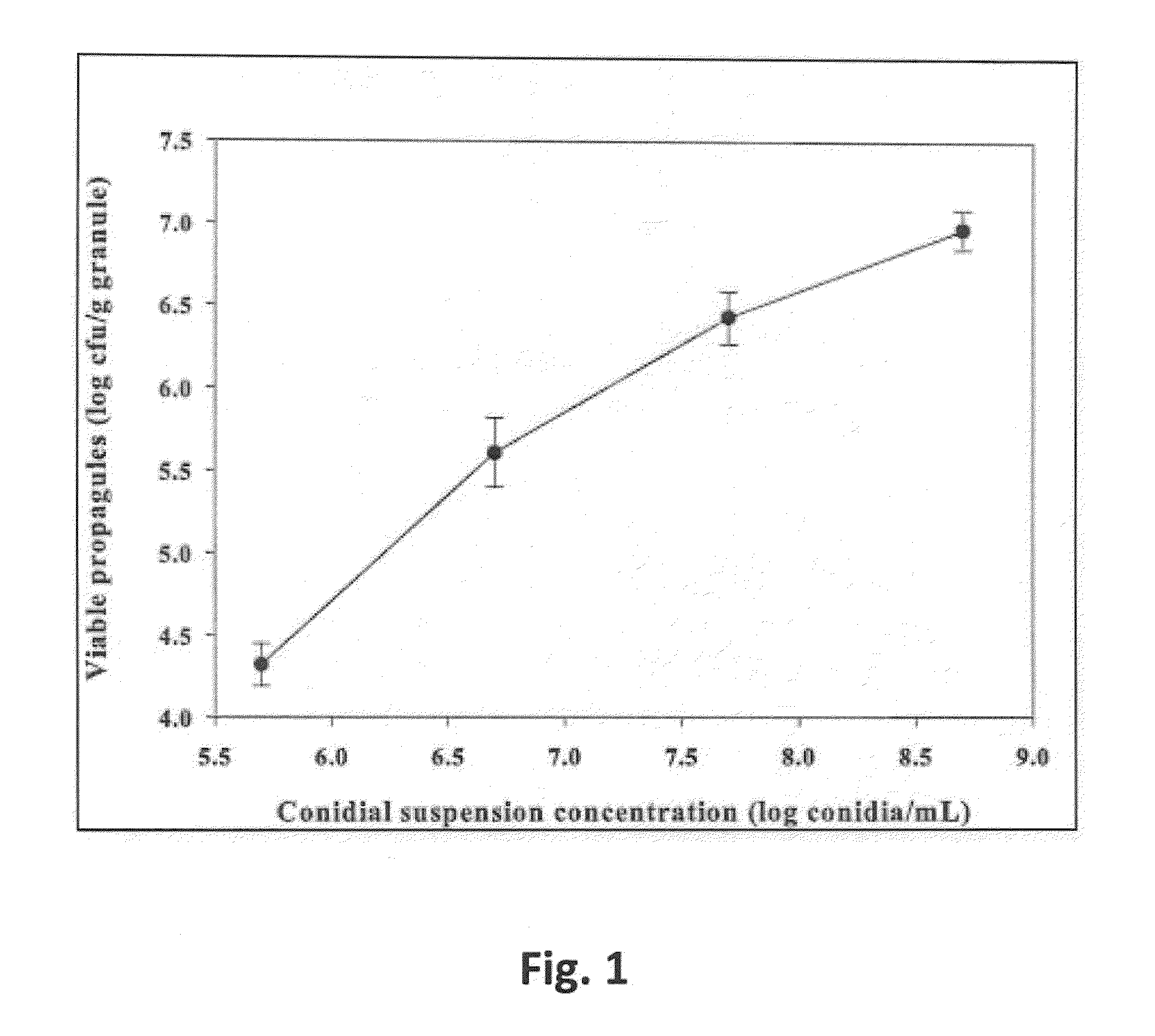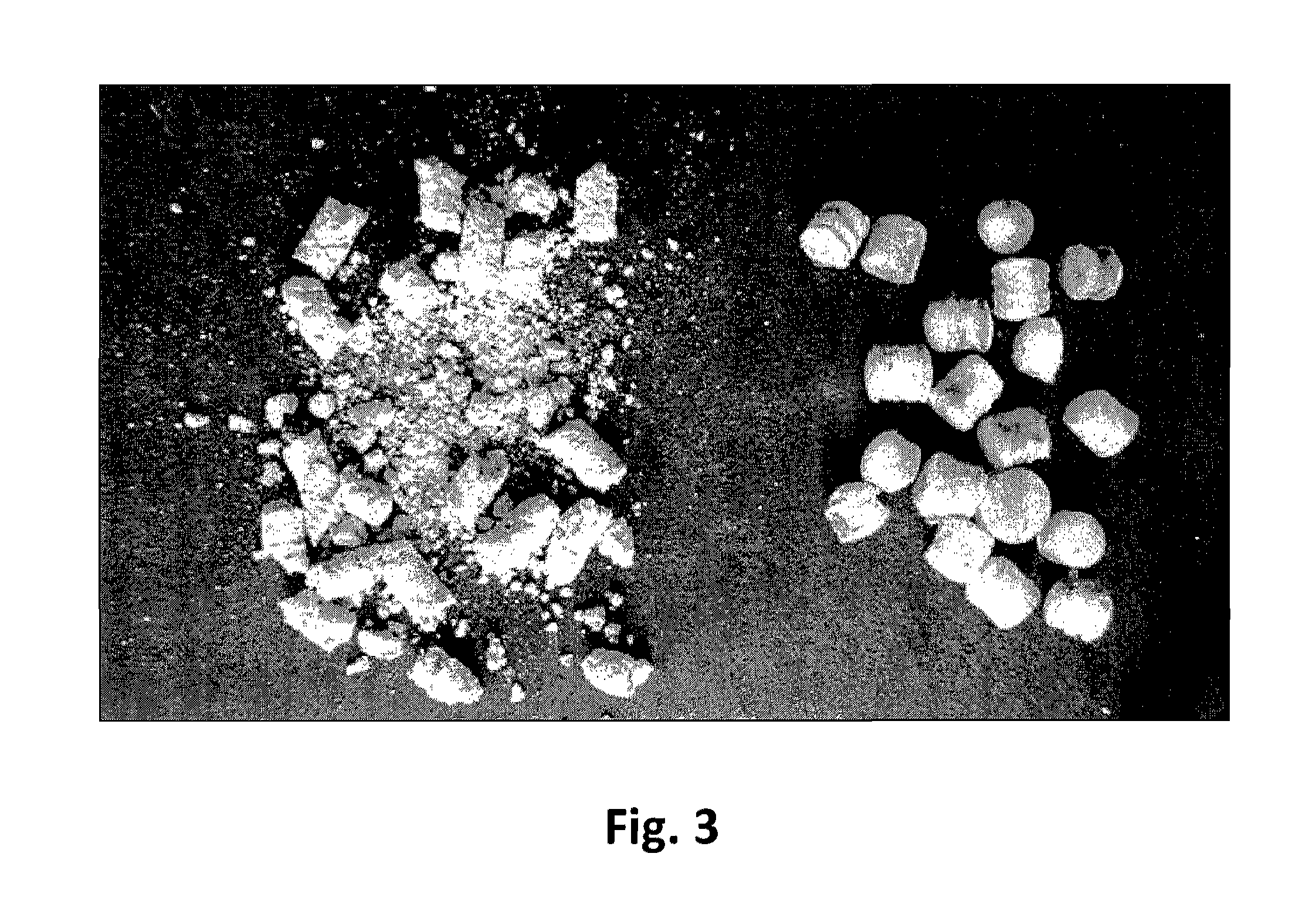Granular bioplastic biocontrol composition
a bioplastic and composition technology, applied in the field of biocontrol formulations, can solve the problems of difficult management of aflatoxin-producing fungi in corn, and achieve the effect of reducing aflatoxin contamination
- Summary
- Abstract
- Description
- Claims
- Application Information
AI Technical Summary
Benefits of technology
Problems solved by technology
Method used
Image
Examples
example 1
Aspergillus flavus Strains and Soil
[0042]Two strains of A. flavus were selected for this study; the non-aflatoxigenic strain A. flavus NRRL 30797 (K49) and the aflatoxin-producing A. flavus NRRL 30796 (F3W4). Properties of the two strains have been previously described (Abbas et al. 2006, supra; Accinelli et al. 2008. Canad. J. Microbiol. 54: 371-379). Fresh conidia were generated by plating 108 spores per ml on acidified potato dextrose agar (PDA) and incubating at 37° C. for 5-7 days. A total of 5 ml of sterile 0.2% Tween 20 was added per plate, and conidia were collected by gentle scraping. Conidia concentration was determined using a hemocytometer and adjusted as necessary.
[0043]Soil used in this study was collected on December 2007 from a 1-ha uncropped area located at the experimental farm of the University of Bologna, Italy. The soil was classified as a Cataldi silty loam (Udic Ustochrepts, fine silty, mixed, mesic) with 380 g / kg sand, 245 g / kg clay, 375 g / kg silt, 8.5 g / kg o...
example 2
Preparation of the Mater-Bi®-A. flavus Biocontrol Composition; Preparation of Pesta Granules
[0044]Granules of Mater-Bi® ZF03U / A (MB) with average size of 5 mm long and 3 mm diameter were supplied by Novamont S.p.A. (Novara, Italy). Conidia from the A. flavus NRRL 30797 were entrapped within the MB granules by equilibrating the granules in conidial suspensions ranging from log 5.7 to log 8.7 conidia / mL for 4-hours with shaking (300 rpm). After this incubation, the conidial suspensions were then forced through these impregnated granules using a piston-like device at a pressure of 62 kPa (Riff98, Italy). Finally, granules were dried at 40° C. for 2 hours and surface cleaned by flushing compressed air generated from a commercial air-compressor. The total number of entrapped A. flavus conidia in the granules was evaluated by plate count. Evaluations of colony forming units on granular surface, shelf life of granules, and MB ability to support growth and sporulation were determined as des...
example 3
Enumeration of A. flavus Colony Forming Units
on the Surface of Mater-Bi® Granules
[0046]Another essential prerequisite for any biopesticide is that it should be safe for operators. Even though A. flavus NRRL 30797 is a proven non-aflatoxigenic strain (Abbas et al. 2006, supra), our efforts were directed to making a solid formulation with fungal propagules mostly entrapped within the granules in order to reduce risks of mold inhalation during handling and field application.
[0047]Estimates of the percentage of A. flavus conidia located on the granule surface were determined by exposing the granules to UV rays for 60 min using a model G20T10 UV germicidal lamp (Sankyo Denki, Japan). The difference in the total colony forming units (cfu) of unexposed and UV exposed granules gave an estimation of the propagules present on the granule surface after air-pressure cleaning.
[0048]Exposing granules to germicidal UV light led to a 25% decrease of recoverable propagules, thus confirming that most...
PUM
 Login to View More
Login to View More Abstract
Description
Claims
Application Information
 Login to View More
Login to View More - R&D
- Intellectual Property
- Life Sciences
- Materials
- Tech Scout
- Unparalleled Data Quality
- Higher Quality Content
- 60% Fewer Hallucinations
Browse by: Latest US Patents, China's latest patents, Technical Efficacy Thesaurus, Application Domain, Technology Topic, Popular Technical Reports.
© 2025 PatSnap. All rights reserved.Legal|Privacy policy|Modern Slavery Act Transparency Statement|Sitemap|About US| Contact US: help@patsnap.com



